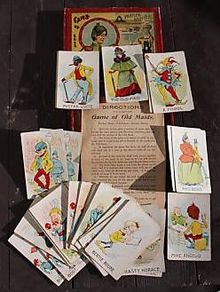Oh Hell, Oh Pshaw or Nomination Whist is a trick-taking card game in which the object is to take exactly the number of tricks bid. Unlike contract bridge and spades, taking more tricks than bid is a fail. It was first described by B. C. Westall around 1930 and originally called Oh! Well, and was said to have been introduced into America via the New York clubs in 1931. It has been described as "one of the best round games."

Black Lady is an American card game of the Hearts group for three to six players and the most popular of the group. It emerged in the early 20th century as an elaboration of Hearts initially also called Discard Hearts, and is named after its highest penalty card, the Queen of Spades or Black Lady. It is a trick-avoidance game in which the aim is to avoid taking tricks containing hearts or the Black Lady. Culbertson describes it as "essentially Hearts with the addition of the queen of spades as a minus card, counting thirteen" and goes on to say that "Black Lady and its elaborations have completely overshadowed the original Hearts in popularity."

Donkey, also known as Pig, is a collecting card game that is best for five or six players. It is played with a 52-card French pack. It has variants such as Spoons and may be descended from an old game called Vive l'Amour.

Brag is an 18th century British card game, and the British national representative of the vying or "bluffing" family of gambling games. It is a descendant of the Elizabethan game of Primero and one of the several ancestors to poker, the modern version just varying in betting style and hand rankings. It has been described as the "longest-standing British representative of the Poker family."

Cheat is a card game where the players aim to get rid of all of their cards. It is a game of deception, with cards being played face-down and players being permitted to lie about the cards they have played. A challenge is usually made by players calling out the name of the game, and the loser of a challenge has to pick up every card played so far. Cheat is classed as a party game. As with many card games, cheat has an oral tradition and so people are taught the game under different names.

Mau-Mau is a card game for 2 to 5 players that is popular in Germany, Austria, South Tyrol, the United States, Brazil, Poland, Greece, Czech Republic, Slovakia and the Netherlands. Mau-Mau is a member of the larger Crazy Eights or shedding family, to which the proprietary card game Uno belongs. However Mau-Mau is played with standard French or German-suited playing cards.
Cassino (US) or Casino (Europe), is a fishing card game, often said without substantiation to be of Italian origin, for two, three, four, or even theoretically five players. It is the only fishing game to have penetrated the English-speaking world. It is mostly played by two with a standard deck of playing cards, the object of the game being to score 21 points by fishing up cards displayed on the table. It is very similar to the later Italian game Scopa.

Golf is a card game where players try to earn the lowest number of points over the course of nine deals.

Pyramid is a patience or solitaire game where the object is to get all the cards from the pyramid to the foundation.

Conquian, Coon Can or Colonel is a rummy-style card game. David Parlett describes it as an ancestor to all modern rummy games, and a kind of proto-gin rummy. Before the appearance of gin rummy, it was described as "an excellent game for two players, quite different from any other in its principles and requiring very close attention and a good memory to play it well".
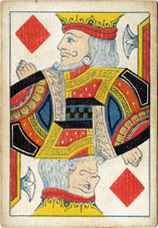
Ranter-Go-Round is a primitive gambling game and children's game using playing cards. It is known in most European countries as Cuckoo; the French variant being called Coucou. Other English-language names include Chase the Ace, Cuckoo and, in America, as Screw Your Neighbor.

The following is a glossary of terms used in card games. Besides the terms listed here, there are thousands of common and uncommon slang terms. Terms in this glossary should not be game-specific, but apply to a wide range of card games. For glossaries that relate primarily to one game or family of similar games, see Game-specific glossaries.
Bohemian Schneider, sometimes Bohemian Tailor, is a card game for two people, which is played with a German-suited Skat pack of 32 cards. Because it is a simple trick-taking game, it is often played by older children and is recommended for age 8 upwards. It was probably developed in Bohemia and spread from there across the south German region and Austria.

Tapp Tarock, also called Viennese Tappen, Tappen or Tapper, is a three-player tarot card game which traditionally uses the 54-card Industrie und Glück deck. Before the Anschluss (1938), it was the preferred card game of Viennese coffee houses, for example, the Literatencafés and Café Central. Even today Tapp Tarock is played sporadically. The exact date when it appeared is not possible to identify; some sources suggest it may have been developed in Austria in the early 19th century, but its mention in caricature operas in 1800 and 1806 suggest it was well known even by then and must have arisen in the late 18th century. The oldest description of the actual rules is dated to 1821. Tapp Tarock is considered a good entry level game before players attempt more complex Tarock forms like Cego, Illustrated Tarock or Königrufen.
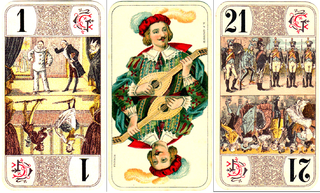
Droggn, sometimes called French Tarock is an extinct card game from the Austrian branch of the Tarock family for three players that was played in the Stubai valley in Tyrol, Austria until the 1980s. Droggn is originally local dialect for "to play Tarock", but it has become the proper name of this specific Tarock variant. An unusual feature of the game compared with other Tarock games is the use of a 66-card deck and that there is no record in the literature of a 66-card game and no current manufacturers of a such a deck. The structure of the game strongly indicates that it is descended from the later version of Tarok l'Hombre, a 78-card Tarock game popular in 19th-century Austria and Germany, but with the subsequent addition of two higher bids.

Binokel is a card game for two to eight players that originated in Switzerland as Binocle, but spread to the German state of Württemberg where it is typically played with a Württemberg pattern pack. It is still popular in Württemberg, where it is usually played in groups of three or four as a family game rather than in the pubs. In three-hand games, each player competes for himself, while in four-hand games, known as Cross Binokel (Kreuzbinokel), two teams are formed with partners sitting opposite one another. The game was introduced to America by German immigrants in the first half of the 20th century, where it developed into the similar game of Pinochle. Binocle was still played in Switzerland in 1994. In south Germany, the game is sometimes called by its Swabian name, Benoggl.
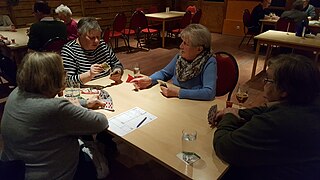
Fipsen or Fips is an old north German card game for 4 or 5 players that resembles Nap and Mau Mau in some respects. It is a trick-taking game played with a standard Skat pack that was once popular across North Germany in the former states of Schleswig, Holstein, Mecklenburg and Pomerania, but is now restricted to the south Holstein region. In the village of Thedinghausen in Lower Saxony, a rather different game is played under the same name for currant buns called Hedewigs. It has been described as "quite a special card game" that is "ancient, but very easy to learn".
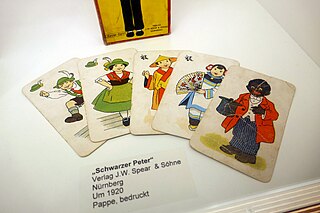
Black Peter is the English name of the European game of Schwarzer Peter which originated in Germany where, along with Quartett, it is one of the most common children's card games.

Kosakeln ("Cossack") is a relatively recent, two-hand card game of the Austrian branch of the Tarock family. It is a two-handed version of the three-player game of Illustrated Tarock, itself an elaborate and challenging variant of Tapp Tarock.

Vieux Garçon or Le Pouilleux ("Scruffy"), also sometimes called Mistigri, Le Pissous, Le Puant ("Stinker"), Pierre Noir or Le Valet Noir, is a game which requires 51 cards, i.e. the standard 52-card pack minus the Jack of Clubs. It is a game for two to eight players. It is of the same family as Old Maid and Black Peter.
